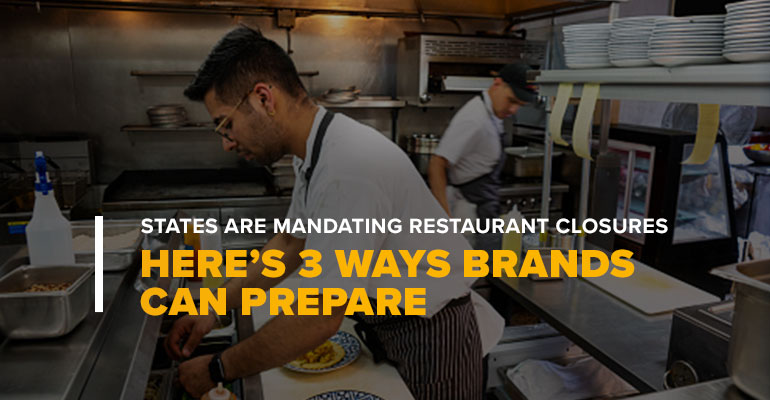March 2020 — Published in RestaurantDive - Lease agreements, perishable inventory and off-premise strategy will need to be assessed to weather COVID-19.
On Sunday afternoon, Ohio Governor Mike DeWine announced that restaurants were closed to dine-in customers beginning at 9 p.m. that day. With just six hours to go, owners and operators scrambled to get their businesses ready.
As the novel coronavirus spreads across the country, state and city governments are forcing restaurants to close their dining rooms and offer food only through mobile pickup or delivery to curb exposure.
As of press time, Michigan, Ohio, Illinois, New York, Rhode Island, Maryland and Massachusetts all officially barred restaurants from serving food on-premise. With additional markets seemingly on the brink of similar announcements — California and Pennsylvania are encouraging, but not requiring, restaurants to close in-store operations while Wasington, D.C has required restaurants to reduce occupancy and eliminate bar seating — it seems inevitable that the industry will see a wave of new regulations this week.
No U.S states or municipalities have instructed restaurants to cease operations entirely, and the White House is reportedly considering a nationwide curfew to keep consumers from entering bars and restaurants at night, which could serve as an alternative to restaurant closures. Still, full-stop closures may be just around the corner given the experiences of countries with more advanced COVID-19 outbreaks, such as China and Italy. American restaurants need to prepare now for impending closure announcements and should expect very little turnaround time to make changes. Many impacted regions have given restaurants only 24 hours to comply with off-premise only mandates. Michigan eateries, for example, had less than four hours to adjust their operations.
Restaurant Dive spoke to industry experts about how restaurants can prepare now for mandated operational changes or full closures to minimize disruption and protect their profitability. Here’s what we learned:
1. If delivery is still allowed, anticipate demand fluctuations
When optimizing your operations for off-premise only service, it’s important to take the state of surrounding businesses into account, Mark Heymann, CEO and co-founder of Unifocus, a workforce solutions company for the service industry, told Restaurant Dive. If the local community workforce is still commuting into their offices as normal, restaurants could see an influx of delivery or catering orders during lunch hour, he said.
Restaurants should also consider extending their hours to capture more delivery demand as they put more muscle behind their off-premise operations — existing hours geared toward on-premise dining may be too restrictive.
“You need to consider expanding your hours of operation,” Heymann said. “So, for example, you normally close at 11 o'clock at night. Is there [now] going to be demand until one in the morning?”
Casual dining restaurants and family eateries should also explore reallocating front-of-house employees to the kitchen to help sustain delivery demand and keep operations running smoothly.
Adding more consumer touchpoints, like accepting orders via phone, could be another way to widen a restaurant’s reach and capture more sales, Heymann said. This is also a key time for restaurants to develop delivery promotions they can share on social media and push through their branded channels, like mobile apps and email, to keep their business competitive and top of mind, he added.
“Is your website easy to order from? Is there a way to quickly adjust that? Technology will play a role here because this thing is not going to be over in a week or two,” Heymann said. “But obviously there’s a break-even point as well. Can you afford [to make website changes]?”
Restaurants that don’t currently offer delivery should take advantage of offerings from platforms like Grubhub and Postmates, who are waiving commission fees for new independent partners to reduce COVID-19’s impact on bottom lines, Andy Rosenbloom, VP of marketing for Buyers Edge Platform, a foodservice specialist services company, told Restaurant Dive.
2. Take stock of perishable inventory and make a plan
If a restaurant chain were forced to close operations entirely, it would probably be sitting on thousands of pounds of perishable produce in its fridges, Heymann said. Because of this, it’s important for restaurants to take careful inventory of all perishable and nonperishable goods in its system and make a plan for how to optimize what they have.
Restaurants should pause ordering new fresh ingredients and rework their menus around what they already have in stock, Rosenbloom said. This could also be a good opportunity to build new delivery-only menus that spotlight the ingredients that will go bad the fastest.
“[Restaurants] should probably create limited menus for carryout that focus on what’s already in stock… and their perishables as much as possible so they don’t wind up with a ton of food waste,” Rosenbloom said. “That comes with downsides because switching up menus is a little bit disruptive… but restaurants [need to] focus on the short term. It’s tough to say how long restaurants are going to stay open even just for takeout.”
Restaurants could also consider putting together special to-go meals that mimic meal kit-style packages, where the food isn’t fully prepared or assembled, to get ingredients out the door and bring a sense of excitement to the menu, he said.
In a worst-case scenario, restaurants could explore selling excess inventory to hospitals or grocery stores, or donate the fresh ingredients to a charity, though some restaurants have been reluctant to do so in the past due to perceived liability issues.
“Who do you sell [inventory] back to? Canned goods are one thing, but you have perishables in your refrigerator. You’re probably going to lose money on that inventory,” Heymann said. “These are questions that have not been answered.”
Now is also a good time for restaurants to ensure that they have robust supply of delivery and takeout packaging to meet increased off-premise demand, Rosenbloom said.
3. Optimize post-closure downtime
If and when restaurants are forced to halt operations completely, that doesn’t mean that rents will be frozen. Restaurants should speak with their landlords to gauge whether they would abate rent and interest payments in the case of a temporary, mandatory closure.
“It’s easy to say ‘close your restaurant.’ It’s another thing to say ‘what’s the full impact of this?’” Heymann said. “It’s not quite so simple in economic effect … when you look at the ramifications of [closures] it becomes far more complex.”
Restaurants should also prepare to use this quiet time to plan out the rest of 2020 and seek new partnership opportunities and other strategies that can best position their business once closures are lifted.
“If we do see a certain slow down… it’s a good time, I think, for restaurants to spend a little time to make sure they have everything in place to have a successful rest of the year,” Rosenbloom said. “That includes things like inventory practices, menu planning and promotion planning … If [restaurants] wind up shutting down, that doesn’t mean that there’s not opportunities for them to do things that are beneficial for their business.






